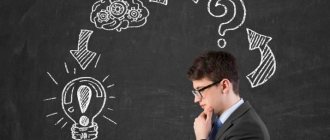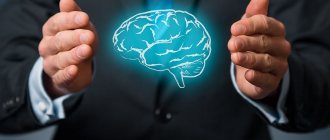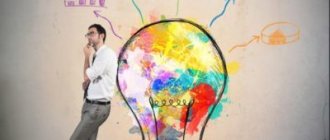Thinking and speech are what distinguishes a person from an animal. Verbal and logical thinking is inherent only to man; it is formed in the process of his development and maturation.
Thinking is the highest level of cognition, the process of recreating the reality around us. Thinking is often identified with the mind. This is not entirely true.
If the mind is the ability to think and find solutions to various problems, then thinking is a prerequisite of the mind , a tool of a thinking person, working with meanings.
What is logical thinking
The concept is conventionally divided into two components: thinking and logic. The first is the process of obtaining and analyzing information, searching for connections between objects, events, and other parts of reality. For its correct operation, logic is needed, otherwise the detected connections will be erroneous and will not be able to reflect the true state of affairs.
Logic has several definitions, some of which are related to the translation of the word denoting it from Greek. Generally speaking, this is the science of the intellectual mental activity of the brain. Its main task is to find a way out of the situation using the existing premises, and also, through reflection, to better understand the features and nuances of any subject.
The above helps explain what logical thinking is. It is a thought process that requires the application of logical concepts. It requires evidence and prudence. Designed to draw a conclusion based on premises.
Logical thinking has five properties:
- It is formed exclusively experimentally. A person found himself in a certain situation, found a way out of it, faced the consequences and made a series of conclusions. This process is called empirical knowledge.
- It is an acquired, not an innate quality of a person.
- Many people unconsciously avoid developing logic, not wanting to leave their comfort zone.
- Logic sometimes pushes people to inhumane acts, since it is akin to cynical calculation. Together, these two concepts relegate self-sacrifice and philanthropy to last place. A good example is maniacs with a disturbed psyche. Actions that are scary for a normal person are quite logical for them.
- Logic is clearly visible in science. Take, for example, the axioms, deviation from which is usually called a disorder.
Logical thinking is a tool for processing information and forming conclusions. Thanks to him, a person analyzes, evaluates what is happening around him, and also competently presents the information received to his interlocutor.
Communicative Gestures
Gestures-emblems
An emblem is a communicative gesture that does not accompany speech, but in fact is speech itself, because it has a very specific meaning. A person showing an emblem gesture always does it consciously and intentionally. Emblems and emblematic signs are a proto-language. Our ancestors, who did not know or speak the language in its modern form, communicated using emblems.
The meaning of emblem gestures is unambiguously interpreted by all representatives of a given culture or subculture. With the help of emblems, you can convey almost any message, including factual information, orders, expressions of personal attitude and feelings.
Facial expressions and eye movements accompanying emblem gestures expand the boundaries of possible meanings associated with hand movements. And there is always the possibility that the meaning associated with a gesture in the absence of speech will change if it is accompanied by speech, including in those cases where the accompanying speech appears to be superfluous. However, context expands the boundaries of meaning. Sometimes context does not greatly influence the meaning of a gesture, but only slightly changes how it is performed.
Two types of emblem gestures
- Iconic (arise in human culture by copying real objects and actions performed with them);
2. Symbolic (do not contain a direct reflection of the appearance of the depicted object or action, therefore they are understandable only to dedicated people).
Since emblem gestures are a proto-language, passed down from generation to generation and reinforced by cultural traditions, in the event of an internal conflict they can manifest themselves in some way.
In body language there is one informative sign of deception - an emblematic clause, which occurs when a person does not believe what he is saying, that is, the body contradicts the words.
An emblematic clause can be a sure sign that the speaker is lying.
Criteria for an emblematic clause
- The reservation usually appears outside the usual position. Emblems are displayed intentionally, they convey some kind of signal, a message, and the emblematic leak seems to involuntarily burst out, and therefore appears outside the usual position;
- The reservation may not be fully manifested, but partially;
- The reservation may be characterized by excessive "brokenness" in the display of emblems. Since liars, when attempting to lie, are characterized by bodily asymmetry, when attempting to consciously control and suppress emotions, the emblematic clause takes on part of this bodily asymmetry.
During the interview, the verifier may see emblematic leaks in the person being interviewed, but they may not appear. Despite the fact that emblematic clauses are a fairly reliable sign of a lie, the verifier cannot fully rely on them alone, because they may not appear at all during the interview conversation. You also need to master the linguistic set of gestures-emblems of different nations and nationalities, especially when conducting inspections in neighboring states.
Gesture illustrators
Another type of gestures characteristic of humans are illustrative gestures - gestures that accompany speech. Illustrative gestures must be interpreted even more carefully than emblem and adapter gestures.
Types of Illustrator Gestures
- Accurate capture of the void;
- Precise grip of an object;
- Forceful capture of the void;
- Powerful grip of an object;
- Strike the Void;
- Piercing gestures;
- Forefinger;
- Intent to touch;
- Reaching out your arms (palms up, palms facing you, palms down, palms forward);
- United hands;
- Head - body;
- Illustrations feet
Ways to illustrate speech
- A person may place particular emphasis on a word or phrase;
- A person can trace the course of thought in the air with his hand, as if conducting his speech;
- The person may draw with their hands in the air or perform actions that repeat or reinforce what has been said.
Using Illustrator Gestures
- An attempt to explain something that is difficult to express in words;
- Inability to find the right word or phrase;
- Communication of speech;
- Emotional excitement.
Functions of illustrator gestures
- Repetition - When communicating, people sometimes simply repeat with gestures what they say verbally;
- Complementation - During the communication process, people use gestures to complement or clarify what they say in words. When words and gestures complement each other and are not in conflict, the messages are decoded by the interlocutor more accurately;
- Recall – sometimes nonverbal cues help us remember a verbal message;
- Substitution – sometimes nonverbal cues can replace verbal cues;
- Emphasis or muting - a nonverbal message can soften or mute a verbal message or emphasize certain words (markers).
The intensity of the manifestations of illustrative gestures is influenced by the character of the person (there is a type of people for whom intense gestures are not characteristic), and is influenced by culture and cultural affiliation. Therefore, one of the tasks of the verifier at the stage of establishing the baseline of behavior is to determine the intensity of the illustrators’ manifestation in the norm. Typically, the normal expression of illustrators can be observed by talking about everyday topics.
Verifiers need to understand and take into account the person's nervous system as well as their baseline behavior, because some people tend to increase the number of illustrative gestures during a lie, while others tend to decrease the number of illustrative gestures during a lie. Depending on the psychotype of the person being interviewed, as well as on the strategy of lying chosen by him, this tendency will manifest itself.
Gesture controls
Regulatory gestures are interactive gestures that help regulate dialogue.
Types of gesture controls
- Gestures for transmitting information;
- Gestures-references to the interlocutor’s statement;
- Gestures for adjusting the order of remarks;
- Gestures for requesting the interlocutor's reaction.
Components of logical thinking
As stated above, thinking and logic are tools for obtaining and processing information. The process involves creating a certain image that allows you to imagine an object or person located in another place. It comes in several types.
Figurative-logical thinking
In another way it is called visual-figurative. It is a thought process during which a person visually plays out the current situation. Essentially, it is imagination that allows you to recreate vivid, realistic pictures in your brain. The development of this type of logic begins at about one and a half years.
You can check the presence of this ability using the Raven test. The psychologist shows the person sixty tables, each of which contains several pictures without text. They have some kind of connection with each other. At the bottom there are up to 8 figures, one of which is missing. The subject should identify the pattern and find the required detail.
Developmental tasks
For schoolchildren (primary classes)
- "Analogy". Continue row 2, 4, 8, 16.
- "Elimination of the superfluous." The odd one out is chosen from a series of numbers.
- "At worst". Prove the statement for the most inconvenient case.
- "Classification". Divide objects into subsets based on similar characteristics.
Logic problems arouse children's interest in the subject. Weighing and transfusion tasks help in life. To solve problems use:
- reasoning;
- tables;
- block diagrams;
Applying logic
Logic and thinking are used in almost all areas of life. They will be needed by humanists, economists and businessmen, speakers, and artists. Only in some cases will they be strict and formalized (technology, mathematics). Others will require more imagination. With its help, a person analyzes the facts and draws conclusions.
Knowledge of the surrounding world is based on all types of logical thinking. They help you learn a number of useful life techniques:
- choose the path leading to the correct conclusion;
- think quickly and fruitfully;
- present information clearly;
- protect yourself from misconceptions;
- see and correct errors in other people's thinking.
Logic also makes it possible to quickly find arguments and use them in a dispute.
Brain fitness secrets
You can learn about the specifics and results of developing thinking abilities at special trainings. Brain fitness includes programs and exercises similar to physical training. Parameters and performance of the intellect are improved: super-memory or speed reading. Almost any such courses require logic and develop it. You just need to choose your field correctly, be it science, business, improving a child’s abilities, or something else.
Features of the development of logical thinking
A person of any age has the ability to receive and analyze information. To put it simply, absolutely everyone can think, since it is an innate function of the brain.
With the help of different parts of logic, a person thinks, plans, makes decisions, and corrects behavior. It turns out that you can develop and train logical thinking.
The process of learning the basics of logic consists of four parts:
- theory;
- generalization, comparison and specification of information;
- accurate presentation of thoughts;
- training in the ability to recognize misconceptions in a timely manner and see errors in judgment.
Also, in the process of developing the verbal-logical type of thinking, a person learns to find arguments that can be used in an argument.
More details about the concepts
It is impossible to understand this issue in detail without finding out the definitions of all terms. Thinking is the process of processing information data and bringing it to a specific conclusion. This ability gave rise to the emergence of speech, which we use to communicate with each other. People come to reflection in order to resolve all troubles and problems, explore the world around them, find out relationships and patterns. By thinking, a person creates innovations, makes scientific discoveries and finds himself in art. Without a mental component, we would be similar to ordinary animals that act within the framework of their instincts.
Forms of thinking are the result of thought and mental processes that manifest themselves in a specific situation, which allows one to understand the essence of phenomena and objects, determine the relationships of objects and notice general signs. There are only three varieties, which I will discuss in detail below.
When logical thinking begins
What is logical thinking? As stated above, this is the ability to analyze information and draw conclusions. It is not innate. The ability to think logically develops as a person grows older.
The first inclinations of logic appear at about one and a half years. This is, one might say, the basic level. A little later, after the child goes to school, he develops an abstract form of logical thinking. And so on.
The development of this type of thinking must begin in childhood. If you solve problems and puzzles with your preschooler, it will be easier for him in adulthood to compare facts and make decisions. Understanding this, specialists include such activities in the kindergarten and school curriculum.
How to develop logical thinking
There are several development methods. They act comprehensively, improving the ability to think as a whole, and not just some of its individual parts.
Reading
You can get a lot of useful information from books. According to experts, they show how to apply logic in practice. There is much more practical knowledge here than in any specialized reference books.
Courses, books for development and training of thinking
It sounds unexpected, but one of the textbooks on developing logical thinking is “Sherlock Holmes” by Arthur Conan Doyle. This book talks about how to use logic in life. Other useful works include:
- “Applied Logic” by N. Nepeyvod;
- “Textbook of Logic” G. Chelpanov;
- “Logic” A. Ivin;
- “Fundamentals of logical rhetoric” by A. Matveev, A. Sarapultsev;
- “Logic in questions and answers” V. Vechkanov, N. Luchkov.
Reading such literature is an opportunity not only to develop logical thinking, but also to improve deduction, learn to use arguments in a dispute, and make the right decisions.
Practice SWOT Analysis
SWOT is an assessment of the Strengths and Weaknesses, as well as the Opportunities and Threats of anything: an idea, a proposal, an object.
It’s easier to explain how this is done with an example. Let's say you're thinking about going out to fast food for dinner. Strengths: fast, cheap, tasty. Weak: harmful, high in calories. Opportunities: no need to prepare, free up time to learn programming. Threats: you can get poisoned or simply overeat, and you won’t want to do anything anymore. You can also analyze the option “write code now” or “take on another freelance job.” And make a rational choice.
Useful tips
To develop logic, it is not enough to pay attention to problems, solve puzzles, crosswords, and read specialized literature. There are some more tips:
- Left-handers should learn to write with their right hand and vice versa. This will improve the functioning of the less developed part of the brain.
- Change the type of activity from time to time. For example, do one thing for an hour or two, and then change jobs.
- Read detective stories, trying to predict what the main character and other characters will do in a given case. This process promotes the development of deduction.
- Explain your actions and actions. A thorough analysis of daily incidents makes it possible to build logical chains and draw conclusions regarding how best to proceed next time.
It is also worth being outside more often. Walking improves brain function in general.
TOP 10 exercises that develop adult thinking
- Solve crosswords and charades.
- Say words and whole sentences in reverse order.
- From the selected passage of text, come up with a piece that is opposite in meaning to the original one.
- Come up with as many characteristics as possible for the chosen words.
- Team exercise: a member of one team performs an action, and the other team looks for the reason for it. For example, someone drank water, the answer to this action would be “the appearance of thirst.”
- Develop your left hand if you are right-handed, and your right hand if you are left-handed. You can start with the simplest thing - holding a spoon or fork.
- Team exercise. Members of one team use random words to describe some children's poem or cartoon that is familiar to everyone. In this case, the names of people and names of animals must be skipped. The opposing team must guess what verse or song is being talked about.
- Based on the listed properties, color, shape, smell, area of use, you need to guess what kind of item we are talking about.
- Without words, you need to show the object, and the participants in the game must guess what it is about.
- You need to come up with the first word - the beginning of an associative series, and after that select as many associations for it as possible. For example, white - snow - winter - cold - Christmas, etc.
These exercises have different levels of difficulty. If you feel that a task is beyond your strength, start with an easier one. The more often and harder you practice, the more developed your thinking will be. In addition, many of the team activities listed above can be a good leisure option with friends and family.
Periodic training of attention and associative thinking has the best effect on the development of fantasy and imagination, and also makes it possible to improve memory, creative activity in any area and, in general, significantly improve the quality of life.











